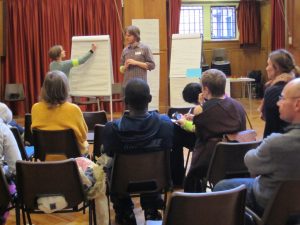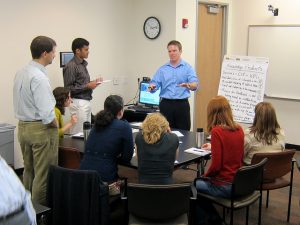
Increasing self-harm (both suicidal and non-suicidal) among young people is a critical concern; the most recent statistics released by Samaritans indicate a rise in suicide death rate among those aged 15-19 (Samaritans, 2016).
A previous large-scale study of Scottish adolescents found that of those who had engaged in self-harm, four out of ten did so with the intent to take their own life (O’Connor et al., 2009).
So when it comes to interventions for youth suicide, where are we really?
Enter Stan Kutcher and his team who, in their recent systematic review, focus their attentions on one popular suicide prevention initiative, safeTALK. The course is described by its developers, Livingworks, as:
Training in suicide alertness [which] helps participants recognize a person with thoughts of suicide and connect them with resources who can help them in choosing to live (Livingworks, 2015)
According to their website, safeTALK has been delivered to more than 273,000 participants, across 20 countries, over the last 10 years (Livingworks, 2015). The idea of the training, which lasts for around half a day, is to increase people’s confidence in asking others if they have been thinking of suicide, and to then connect the person in distress with supportive others, whether that be friends or family, their GP, counsellor, or a support organisation. Given the popularity of safeTALK, what is the evidence behind it?

The safeTALK programme sold by Livingworks has become one of the most popular suicide prevention commercial products in recent years.
Methods
Kutcher and colleagues describe their methodology as a “focused systematic review”. They searched six key databases of medical and psychological literature, checked existing systematic reviews and meta-analyses, searched Google, the websites of various relevant governments and organisations, and also the ‘grey’ (unpublished) literature.
The aim of the systematic review was to:
investigate the quality of available evidence of the effectiveness of SafeTALK.
Results
Surprisingly, if also of concern, there appears to have been only one peer-reviewed study of SafeTALK conducted (Mellanby et al., 2010); the other five pieces of research yielded by the search were one dissertation, and four evaluation reports. Of this sparse literature, the authors say “together, these [studies] constitute the available world literature on SafeTALK.”
Only one of these studies (Eynan, 2011; the doctoral dissertation) performed any type of statistical analysis, finding that those who had received safeTALK training reported significantly higher knowledge and positive attitudes towards suicidal individuals. None of the studies assessed whether safeTALK training affected self-reported suicide attempts, or seeking of medical attention for self-harm or suicidal thoughts. Mellanby et al., (2010) is also the only study to look at young people, but with the mean age of participants being 21, even this may be a stretch.
Kutcher and colleagues report that all of the six studies fall into the ‘insufficient evidence’ category of their quality appraisal, due to “lack of rigor…replication…and statistically significant effect.”

This systematic review found no evidence to support the safety or efficacy of safeTALK.
Conclusions
There is a significant dearth of literature regarding the efficacy and safety of the safeTALK training programme. Furthermore, of the studies that have been conducted, only one has undergone peer-review, and only one has conducted anything other than basic frequency-type statistical analyses.
The one peer-reviewed study (Mellanby et al., 2010) found that those who had received the training felt better equipped to assist someone experiencing suicidal distress; a finding echoed by Eynan (2011), which reported significantly increased knowledge and positive attitudes towards individuals experiencing suicidal crises.

Time to frown? Are you surprised that one of the most popular suicide prevention programmes has no reliable research evidence supporting its safety and efficacy?
Strengths and limitations
This review has drawn attention to an important issue, namely that there is very little evidence for SafeTALK as an effective means of suicide prevention.
Kutcher and his co-authors express significant concern at the apparent lack of evidence for the effectiveness of safeTALK. Indeed, their discussion of the review’s findings calls out various governments and organisations for promoting safeTALK and listing it as ‘evidence-based’ on their websites, when the actual evidence base seems to be thin.
The picture for effective interventions to prevent suicide, in any age group, is rather unclear. Previous reviews of interventions for suicide have remarked that even “national suicide prevention strategies have been proposed despite knowledge deficits about the effectiveness of some key components” (Mann et al., 2005, p.2070).
Just over a decade later, another extensive review of suicide prevention strategies has concluded that many, including gatekeeper training, still lack sufficient evidence of their effectiveness (Zalsman et al., 2016). Look out for a forthcoming Mental Elf blog on that review!
The lack of evidence for safeTALK is really part and parcel of a larger difficulty; that we know very little generally about what works in suicide prevention, not just for this one programme, and not just for young people.
Whilst Kutcher and his co-authors voice numerous criticisms of the studies’ shortcomings, it would have been useful to have more detailed reporting of what the existing evaluations actually found, imperfect as they may be, so that this may inform the development of better evaluations in the future. Four of the six studies performed pre- and post-test assessments, so could chart changing attitudes towards suicide or confidence in supportive suicidal individuals, and the sample sizes of these studies were reasonable.
Important points to consider when developing the evaluation for any type of intervention are:
- What is the purpose (intended outcome) of the intervention/training?
- How can these outcomes be assessed?
- What change in the outcomes will be considered meaningful?
Given the description of safeTALK as being to increase awareness of the signs that someone may be feeling suicidal, to assist people in asking about this and then connecting the person with supportive others, Kutcher et al’s point about none of the studies assessing people’s actual suicidal behaviour is perhaps going beyond the intended primary outcome of the training. Is the purpose of safeTALK to directly reduce suicides, or is it to change people’s attitudes towards and awareness of individuals who may be feeling suicidal; to act as a stepping stone to more intensive suicide prevention? A previous review by Katz et al., (2013) also highlighted that the vast majority of studies on school-based interventions for suicide prevention do not use suicide attempts or suicide deaths as the outcome measure, rather they examine increased confidence and awareness in supporting those who may be suicidal.
Several times the authors raise the following point regarding safeTALK and other similar training programmes:
Correlational to the increased application of these programs has been an increased rate of youth suicide.
Whilst the evaluations of safeTALK are few, and there are no assessments of whether the training does actually reduce suicide, there is also no evidence that safeTALK does any harm or that it increases individuals’ likelihood of suicide. Absence of evidence is not evidence of absence, but it is also not evidence of presence either. None of the studies present any evidence that safeTALK or other similar training causes harm, and indeed neither does the current review.

Do Kutcher et al go beyond the evidence by suggesting that safeTALK may be causing harm?
Summary
Kutcher et al., (2016) found that there were only six studies evaluating safeTALK, and just one of these was peer-reviewed. Whilst the evidence suggests that safeTALK is effective in increasing people’s awareness and understanding of suicide, whether or not this intervention actually reduces suicide is unknown.
So where does this leave us?
Ubido and Scott-Samuel (2014) were also critical of a “strong possibility of bias” regarding suicide prevention and intervention training in their review of Suicide Prevention Training commissioned by Merseyside Directors of Public Health, describing how “all evaluations [were] carried out by those involved in the development of the package, and the evaluation data was collected by the individuals who had delivered the training”.
The question is whether it is preferable to wait for the ‘perfect’ educational intervention or to implement the ‘best available’? Edwin Shneidman (2007) said “…there is a lot of psychological pain without suicide, but there is not suicide without psychological pain.” Suicidal young people are in extreme emotional pain and are often ambivalent about dying. Their lives can be saved, up until the final moment.
Research has shown that encouraging help-seeking behaviour, removing or restricting access to means, and ensuring an appropriate and early response saves lives (Zalsman et al., 2016). Increasing hopefulness, emotional resilience, and helping someone to identify their reasons for living, have all been proven to lead to a reduction in suicide rates. Teenage life is not always straightforward. It can be a challenging and complex time with academic and social pressures that can, at times, create a perfect storm of distress.

Encouraging help-seeking behaviour, removing or restricting access to means, and ensuring an appropriate and early response saves lives.
A significant number of the young people who die by suicide have experienced life events such as bereavement, family ill health, neglect or abuse, but for some it was a more ‘routine’ event such as exam pressure, or common conditions such as asthma or acne, that may have been the ‘final straw’ (National Confidential Inquiry into Suicide and Homicide by People with Mental Illness (NCISH), 2016; Rodway et al., 2016). Recent evidence has also shown that almost half of the young people who took their own lives were not in touch with mental health services around the time of their death (NCISH, 2016). They are, however, almost certainly in contact with someone who could provide an opportunity to support them.
Silence is the big enemy here and encouraging young people to talk is the most important thing. Taking the time to ask a young person if everything is OK and responding in a caring, non-judgmental way is vital for creating a good foundation for discussions. Shame and fear of discovery mean that young people often keep self-harm or thoughts of suicide a secret. The exact reasons why people don’t seek help aren’t known, however it seems likely that stigma is an important factor. On the other hand, some may not disclose because no-one actually asks them if anything is wrong.
Every young person considering self-harm or suicide needs to know they can be supported through tough times. They need a Safety Plan with details of what they can do to help themselves and who they can contact for support. There is an argument for an educational package specifically designed for young people, but it needs to be co-produced with input from young people themselves, piloted, independently evaluated and peer-reviewed and implemented within a robust governance framework.
Information about how to make a Safety Plan can be found in the ‘Feeling Overwhelmed and Helping You Stay Safe’ resource. This is an Interactive online resource for anyone struggling to offer hope, compassion and practical ideas and suggestions on how to find a way forward.

Suicide prevention education for young people should be coproduced, piloted, independently evaluated and peer-reviewed and implemented within a robust governance framework.
If you need help
If you need help and support now and you live in the UK or the Republic of Ireland, please call the Samaritans on 116 123.
If you live elsewhere, we recommend finding a local Crisis Centre on the IASP website.
We also highly recommend that you visit the Connecting with People: Staying Safe resource.
Links
Primary paper
Kutcher S, Wei Y, Behzadi P. (2016) School- and Community-Based Youth Suicide Prevention Interventions: Hot Idea, Hot Air, or Sham? Can J Psychiatry. 2016 Jul 12. pii: 0706743716659245. [Abstract]
Other references
Katz C, Bolton SL, Katz LY, Isaak C, Tilston-Jones T, Sareen J, Swampy Cree Suicide Prevention Team. (2013) A systematic review of school-based suicide prevention programs. Depression and Anxiety, n/a–n/a. http://doi.org/10.1002/da.22114
Isaac M, Elias B, Katz LY, Belik SL, Deane FP, Enns MW, … others. (2009) Gatekeeper training as a preventative intervention for suicide: a systematic review (PDF). The Canadian Journal of Psychiatry, 54(4), 260–268.
Mann JJ, Apter A, Bertolote J, Beautrais A, Currier D, Haas A, … Hendin, H. (2005) Suicide prevention strategies: a systematic review. JAMA, 294(16), 2064–2074.
Mellanby RJ, Hudson NPH, Allister R, et al. (2010) Evaluation of suicide awareness programmes delivered to veterinary undergraduates and academic staff. Veterinary Record. 2010; 167: 730-734. [PubMed abstract]
National Confidential Inquiry into Suicide and Homicide by People with Mental Illness (NCISH). (2016). Suicide by children and young people in England (PDF). Manchester: University of Manchester.
Rodway C, Tham SG, Ibrahim S, Turnbull P, Windfuhr K, Shaw J, … Appleby, L. (2016). Suicide in children and young people in England: a consecutive case series. The Lancet Psychiatry. http://doi.org/10.1016/S2215-0366(16)30094-3
Ubido J, Scott-Samuel A. (2014) Rapid Evidence Review Series: Suicide Prevention Training.
Zalsman G, Hawton K, Wasserman D, van Heeringen K, Arensman K, Sarchiapone M, Carli V, Höschl C, Barzilay R, Balazs J, Purebl G, Kahn JP, Sáiz PA, Bursztein Lipsicas C, Bobes J, Cozman D, Hegel U, Zohar J. (2016) Suicide prevention strategies revisited: 10-year systematic review, The Lancet Psychiatry, Available online 8 June 2016, ISSN 2215-0366, http://dx.doi.org/10.1016/S2215-0366(16)30030-X.

safeTALK for youth suicide prevention: new review finds no evidence of safety… https://t.co/QDTqrzdo4r #MentalHealth https://t.co/XUXPZyM210
Same issue with Mental Health First Aid. Makes trainees feel better, but no evidence to suggest it helps the mentally ill
Mary Dj
Today @LivveyKirtley @AlysColeKing on lack of evidence for school-based youth suicide prevention interventions https://t.co/5tFcw2mJFn
@Mental_Elf “Two programs reduced the risk of suicide attempts: Good Behavior Game and Youth Aware of Mental Health” https://t.co/wMzGV66Ore
@pgmjoh @Mental_Elf Over ten weeks. Harms not assessed.
@afwesty @Mental_Elf GBG has 15 years follow-up, YAM has 1 year.
@pgmjoh @Mental_Elf I don’t understand the attached, then. https://t.co/X5ulp48dk0
@afwesty @Mental_Elf Sry, the review is in swedish, only summary in eng. Papers cited: https://t.co/ZNamr7mgFp https://t.co/WA5leAp2im
@Mental_Elf GBG is often omitted from reviews since it doesn’t focus on suicide prevention. Has broad effects though https://t.co/NGGmDdAvwh
@Mental_Elf @LivveyKirtley @AlysColeKing YAM has evidence of efficacy.
@Mental_Elf @LivveyKirtley @AlysColeKing How about tools such as preventanomics by LSE which examines secondary+ outcomes from projects?
@MrsEmmaJK @Mental_Elf @LivveyKirtley interesting – pls tell us more?!
@AlysColeKing @Mental_Elf @LivveyKirtley A Better Start is using Preventanomics via LSE to see the outcomes that projects & programmes …
@AlysColeKing @Mental_Elf @LivveyKirtley … get and quantify all the objectives achieved by the programmes so younger your evidence :)
@AlysColeKing @Mental_Elf @LivveyKirtley Younger? You get your data is what I meant, ha ha ha! Sorry!
@AlysColeKing @MrsEmmaJK @Mental_Elf Sounds like an interesting approach! Any links please?
@LivveyKirtley @AlysColeKing @Mental_Elf I found a doc relating to them & it but it focuses on how it lists costs https://t.co/hI0Igb2zsw
@LivveyKirtley @AlysColeKing @Mental_Elf When I went to collaboration event for A Better Start, they showed how it could quantify outcomes
@LivveyKirtley @AlysColeKing @Mental_Elf I believe the researcher involved is Rehanna Neky (r.neky@lse.ac.uk)
@MrsEmmaJK @AlysColeKing @Mental_Elf Great, thanks!
@LivveyKirtley @AlysColeKing @Mental_Elf Thank you! X
Delighted co-author @Mental_Elf Blog with @LivveyKirtley on safeTALK for youth suicide prevention https://t.co/zG6wI8SXKC via sharethis
@Mental_Elf my experience would echo but a more thorough review would be nice
So when it comes to interventions for youth #suicide, where are we really? New blog and podcast out now https://t.co/5tFcw2mJFn
Encouraging help-seeking, removing or restricting access to means & ensuring appropriate early response saves lives https://t.co/5tFcw2mJFn
Is #safeTALK safe and does it work?
NEW blog & podcast
https://t.co/5tFcw2mJFn
#SuicidePrevention https://t.co/6kaOqxVCVc
@Mental_Elf @AlysColeKing @LivveyKirtley @picardonhealth @MHInnovation @MentalHealthRR @cspyyc @MHChat @MHCC_ @nationalpost @Globe_Health
safeTALK for youth #suicideprevention: new review finds no #evidence of safety or efficacy https://t.co/CsKf3AUNWO
RT @Mental_Elf: Should we invest in #SuicidePrevention programs with no evidence of safety or efficacy? https://t.co/UiuWZzdDv5 https://t.c…
RT @Mental_Elf: Increase hopefulness & emotional resilience
Help ppl identify their reasons for living
https://t.co/4gQb7kq3rT https://t.co…
RT @Mental_Elf: One of most popular suicide prevention programmes has no reliable evidence for its safety/efficacy. Surprised? https://t.co…
safeTALK for youth suicide prevention https://t.co/E0a2SvSc5s
safeTALK for youth suicide prevention https://t.co/DoU3i5qNUw
The headline is a bit misleading as it ‘implies’ that safeTALK is not effective when actually all it is saying is th…https://t.co/8Ub7mixn2C
RT @Mental_Elf: Don’t miss: safeTALK for youth suicide prevention: new review finds no evidence of safety or efficacy https://t.co/5tFcw258…
safeTALK for youth suicide prevention: new review finds no evidence of safety or efficacy https://t.co/py1nMKpmpz
#ICYMI: safeTALK for #youth #suicideprevention: new review finds no evidence of safety or efficacy via @Mental_Elf: https://t.co/51EbX72NCv
RT @Mental_Elf: Most popular blog this week?
@LivveyKirtley @AlysColeKing
safeTALK for #SuicidePrevention
https://t.co/dirWf6cno6 https://t…
I am astonished that an article written by a research psychologist would be so grossly mis-titled – “finds no evidence” – while the entire article is about the lack of scientific research and hence the existing data falls under “insufficient evidence” due to “lack of rigor…replication…and statistically significant effect.” That doesn’t mean someone has found no evidence; that means someone has found a lack of good research. Does anyone consider the effects of such mispresentation? This is poor journalism.
Hi Lana,
Thanks for your comment.
The blog title is: “safeTALK for youth suicide prevention: new review finds no evidence of safety or efficacy”. Clearly the review found some evidence to include in their analysis (6 studies in total, but only 1 peer reviewed piece of research), but the assertion here is that this does not constitute evidence of safety or efficacy of safeTALK.
The 1 peer reviewed study they found was:
Mellanby RJ, Hudson NPH, Allister R, et al. (2010) Evaluation of suicide awareness programmes delivered to veterinary undergraduates and academic staff. Veterinary Record. 2010; 167: 730-734.
http://www.ncbi.nlm.nih.gov/pubmed/21257507
This was a study of 26 veterinary students in Glasgow, who received the safeTALK training and then completed a questionnaire (only 17 completed it) saying what impact they thought it had on them. Our bloggers did not consider this to be evidence for the safety or efficacy of safeTALK. Do you disagree?
Cheers,
André
As I said, “does not constitute evidence” (i.e., as quoted, “insufficient evidence”) does not mean a finding of no evidence. It means a finding of insufficient evidence, or at least relegation to that category. It looks like I am not the only one who finds the title misleading. I find such journalism irresponsible.
[…] Read the accompanying blog: safeTALK for youth suicide prevention: new review finds no evidence of safety or efficacy […]
[…] curtail our application of community based suicide awareness programs such as SafeTalk for which no evidence of effectiveness or safety exist. They are based in part on the untested idea that encouraging public discourse about suicide will […]
[…] prevention is a contentious field with considerable commercial interests, so evidence producers should always ensure that their publications have clear conflicts of […]
This is an interesting thread that has been brought to my attention this week, and disappointing, too. Anyhow, as Dir SP at LW Aus, please go to this link to to see the most up to date evidence of safeTALK and Start training among young people, led by world leading researchers Orygen Youth at the University of Melbourne under Prof Jo Robinson (who led the keynote at IASP World Congress on safeTALK in schools 2019 under the MAPPS study https://www.livingworks.com.au/assets/NSW/LivingWorks-Australia-Suicide-Prevention-Schools-Evidence-Summary-221101.pdf meanwhile, check this out re our Indigenous research. .https://www.livingworks.com.au/assets/News/LivingWorks-I-ASIST-Evidence-Base-A4-Flyer.pdf if you want to challenge this please talk to proud Euralie and Kooma woman, Professor Maree Toombs
Finally both the Royal Commission into Suicide and Mental Health in Victoria recommended LivingWorks safeTALK in schools as did the Federal Productivity Report – moving away from risk assessment clinical pointy end – not everyone who dies by suicide has a mental illness!! The WHO and SAX Institute both also named LivingWorks programs (no one else) for early suicide intervention due to the overwhelming literature checks – the same LW focussed literature that so called competitors put on their websites to show they are evidence informed